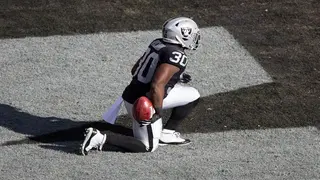What is a touchback in football? Definition, meaning and explanation
Football
Game week 11 of the 2023/2024 Premier League season has been dominated by the controversial nature of how Newcastle United's goal was awarded against Arsenal.
Anthony Gordon's scrappy finish from close range was allowed to stand at St.James Park after more than four minutes of a check from the Video Assistant Referee.

The goal was put through a triple-check of whether the ball had gone out for a throw-in before Joew Willock crossed the ball, whether Joelinton had committed a foul before laying it on to Gordon and whether Gordon himself was offside or not.
What is a touchback in football? Definition, meaning and explanation
Football
Camera angles and footage show that the VAR was right to award the goal on the basis of it not going out completely. Sports Brief breaks down how throw-ins work in football, though in the Newcastle vs Arsenal game, it would have been a goal-kick had Willock not kept it in play.
Law 15 of the revised IFAB Laws of the Game 2023/2024 says:
"A throw-in is awarded to the opponents of the player who last touched the ball when the whole of the ball passes over the touchline, on the ground or in the air."
The phrase 'whole of the ball' used therein is a matter of perspective, given that the ball is a sphere. The VAR makes the review from above the ball to determine if the ball has crossed the line in its entirety.
Now, given that a ball is spherical in shape, a camera angle, as shown in the left-hand side of the below image from BBC Sport, shows that the ball is out.
What does ISO mean in basketball? The ultimate guide to understanding ISO ball
NBA
The image on the right is the same ball with an overhead camera angle, which still shows that a part of the ball is still on the line. It is this image that the officials use to determine whether a ball has crossed a line or not in line with 'the whole of the ball' phrase.
So, in essence, the base of the ball might have crossed the line already(as shown on the left side), but a part of it, due to its spherical shape, is still on the line, which passes it off as a valid ball in play.
The same rule applies with the goal line technology, where a goal is only awarded when the whole of the ball has crossed the line. If any part of its spherical shape is still on the line, then a defender or a goalkeeper can still clear it.
Such are the fine margins in this beautiful, yet at times painful sport.
How handball rules work in EPL after William Saliba, McTominay, Michael Keane penalty decisions
Football
Sports Brief has also reported that former Premier League referee Dermot Gallagher has lifted the lid on why the VAR allowed the goal to stand.
"The whole of the ball has to be over the whole of the line. You can look at it from that angle, and it is impossible to tell," he told the league's website.